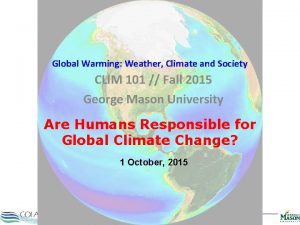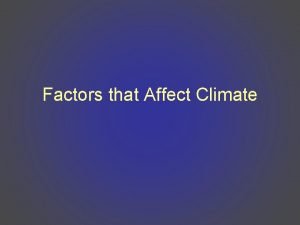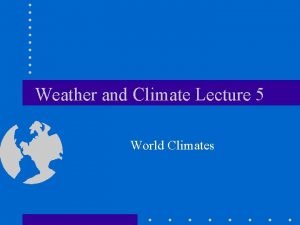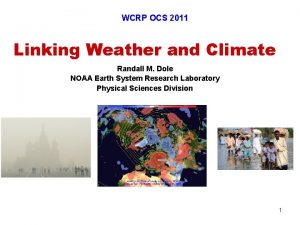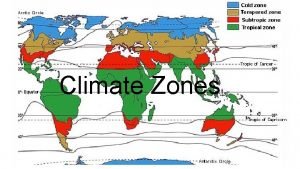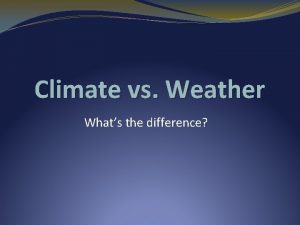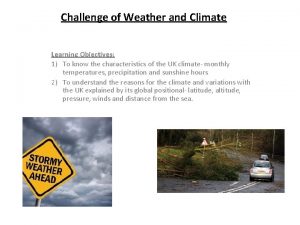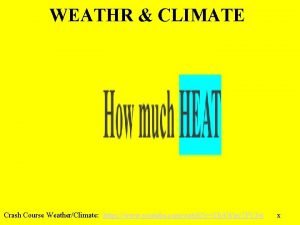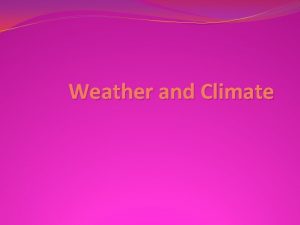Introduction to climate Rangi weather and climate curriculum













- Slides: 13

Introduction to climate Rangi weather and climate curriculum

Weather vs. climate Weather is what you see out your window every day, whether it’s cloudy, rainy, sunny or windy. Weather is what we see and feel in the short-term. It can change quickly, over minutes, hours or a couple of days. Climate describes what the weather is like over a long period of time (years or decades) in a specific area. In short, climate is what we expect, while weather is what we get.


How do we study climate? To study the climate of a particular place, scientists look at averages of rainfall, temperature, sunshine, wind and other measures of weather over a long time, often over 30 years. These long-term averages of weather observations are known as climate normals. Scientists study climate to look for trends and patterns and predict how the climate may change in future.

Why do we have seasons? Here in New Zealand it’s usually warm in January (summer) and chilly in July (winter), But why? It’s because the change in seasons is caused by the tilt of the Earth. The Earth makes a full journey around the sun once per year, but because of the Earth’s tilt the north and south poles sit at an angle rather than straight up and down. This tilt means that the sun’s rays don’t hit Earth equally. The half of the Earth tilted toward the sun receives much more light energy than the half tilted away from the sun.


Why do we have seasons? The half of the Earth tilted toward the sun is experiencing summer, while the half tilted away from the sun is having winter. However, since the Earth’s tilt doesn’t change as it orbits the sun, six months later the opposite half of the Earth is facing toward the sun and is now experiencing summer. This is why Christmas happens in the middle of summer here in New Zealand the rest of the Southern Hemisphere, but in the Northern Hemisphere (places like the United States and Europe), Christmas happens in winter when it’s cold and snowy.

Polar climates are found near the top and bottom of the earth – near the North and South Poles. These areas are furthest away from the equator, meaning they get less direct sunlight than any other places on Earth. Less direct sunlight means colder temperatures, making the poles among the coldest places on Earth. Polar climates experience cool summers and extremely cold winters, which result in land covered in a permanent or semi-permanent layer of ice. To be considered a polar climate, a location must have an average temperature of less than 10°C during all 12 months of the year. However, it can get much colder than that. The coldest temperature ever recorded on Earth is -89. 2°C in Antarctica. Now that is cold!

Desert climates are very dry, hot regions where there is very little rainfall. Deserts are usually rocky or sandy because the little rainfall they receive makes it difficult for plants to grow there. Most deserts are so dry because they have almost constant high pressure (remember high pressure = dry, sunny weather) overhead stopping clouds and rain from forming. Unlike the poles, which get extremely cold, temperatures in deserts can get extremely hot. The hottest temperature ever recorded on Earth was an incredible 56. 7°C in Death Valley, California.

Tropical climates can be thought of as the opposite of polar climates. They are usually found near the equator, and are among the warmest regions on the planet. Temperatures in the tropics change very little throughout the year and it usually rains a lot. Because of all this rain, tropical regions usually have lots of lush vegetation and a large variety of animals living in them.

Temperate climates are considered to be those found between the polar climates and the tropical climates. In these regions , temperatures can change quite a bit during the year and there are usually four distinct seasons. This may mean that it’s hot and humid during the summer, but in winter it can snow and be very cold. New Zealand has a temperate climate.

Video: Weather Tips from Weather Nerds - Seasons

Kahoot quiz: Introduction to climate
 Ka whakairia te tapu
Ka whakairia te tapu Karakia ko rangi ko papa
Karakia ko rangi ko papa Ko rangi ko papa
Ko rangi ko papa Arteriyadan qon ketganda birinchi yordam
Arteriyadan qon ketganda birinchi yordam World geography chapter 3 weather and climate
World geography chapter 3 weather and climate Clim 101
Clim 101 How does wind affect weather and climate
How does wind affect weather and climate Cimates
Cimates Conclusion of weather and climate
Conclusion of weather and climate Climate zones and weather worksheet answer key
Climate zones and weather worksheet answer key Whats the difference between weather and climate
Whats the difference between weather and climate Objectives of weather and climate
Objectives of weather and climate Weathevr
Weathevr Zonas templadas
Zonas templadas





